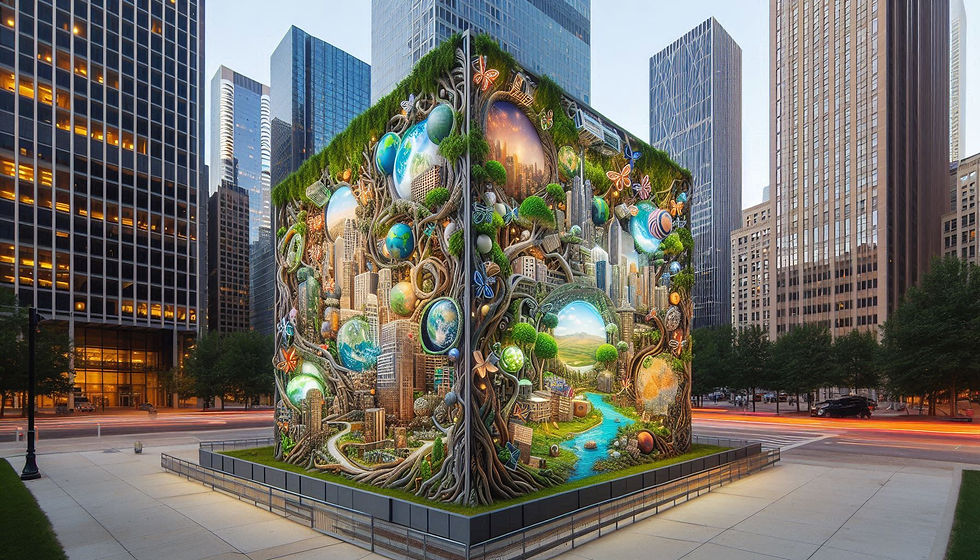"Exploring the Impact of Sustainable Public Art Installations on Urban Environments"
- studioseventhspace
- Aug 5, 2024
- 3 min read
Sustainable public art installations are transformative elements in urban environments, merging artistic expression with ecological consciousness. These installations do more than beautify cityscapes; they embody principles of sustainability, engage communities, and foster environmental awareness. Their impact extends beyond aesthetics, influencing social dynamics, environmental stewardship, and urban vitality.

1. Environmental Benefits
Resource Efficiency: Sustainable public art installations often utilize recycled or eco-friendly materials, reducing the environmental impact associated with production and disposal. Artists might use repurposed materials, such as reclaimed wood or metal, to create visually compelling works while minimizing waste.
Energy and Water Conservation: Some installations incorporate energy-efficient lighting, solar panels, or water-saving features. For example, a public art piece could use solar-powered LEDs or integrate rainwater harvesting systems, contributing to the overall reduction in the urban environment’s energy and water consumption.
Urban Ecosystem Enhancement: By integrating elements such as green walls, vertical gardens, or living sculptures, these art installations can support urban biodiversity. They create habitats for local wildlife, contribute to air purification, and help mitigate the urban heat island effect, enhancing the ecological balance within city landscapes.

2. Social and Community Impact
Cultural Enrichment: Sustainable public art installations reflect and celebrate local culture, history, and values. They provide a platform for community expression and identity, fostering a sense of pride and connection among residents. Artworks that incorporate local stories or themes can enhance cultural awareness and community engagement.
Public Engagement and Interaction: These installations often encourage interaction and participation. Interactive elements, such as movable parts or touch-sensitive features, invite people to engage with the artwork, promoting social interaction and communal experiences. Public art can also serve as a gathering place, enhancing social cohesion and community bonding.
Educational Opportunities: Many sustainable public art projects include educational components that inform the public about environmental issues and sustainable practices. By highlighting themes such as recycling, conservation, or renewable energy, these installations raise awareness and inspire behavioral change towards more sustainable living.

3. Economic and Urban Development
Enhancing Urban Spaces: Sustainable public art installations contribute to the beautification and revitalization of urban areas. They transform underutilized or neglected spaces into vibrant, attractive destinations, which can boost foot traffic and stimulate local businesses. Well-designed art installations can become landmarks, drawing tourists and enhancing the city's appeal.
Economic Stimulus: The creation and maintenance of public art installations generate economic activity by creating jobs for artists, contractors, and maintenance personnel. Additionally, they can increase property values in the surrounding area, contributing to economic growth and urban development.
Long-Term Value: Sustainable art installations are designed for durability and minimal environmental impact, ensuring long-term value. Their ability to withstand weather conditions and require less maintenance reduces future costs and prolongs their impact on the urban environment.

4. Resilience and Adaptability
Climate Adaptation: Many sustainable public art installations are designed with resilience in mind. For instance, art pieces that incorporate green infrastructure can help manage stormwater runoff and reduce flood risks. By addressing climate-related challenges, these installations enhance the adaptability of urban spaces to changing environmental conditions.
Flexibility: Sustainable art installations are often adaptable and can be modified or updated to reflect evolving community needs and preferences. This flexibility ensures that public art remains relevant and continues to engage and inspire over time.

Conclusion
Sustainable public art installations offer profound benefits to urban environments by integrating artistic creativity with environmental responsibility. They enhance ecological health, foster community engagement, stimulate economic growth, and contribute to the resilience of urban spaces. By embracing sustainability in public art, cities can create vibrant, meaningful, and enduring spaces that reflect their commitment to both cultural and environmental stewardship. Through thoughtful design and implementation, sustainable public art installations not only beautify cities but also contribute to a more sustainable and harmonious urban future.

At Seventh Space Studio, we are passionate about transforming urban environments through sustainable art installations. Our commitment to integrating creativity with environmental responsibility drives us to design and create art that not only beautifies public spaces but also aligns with our planet's needs.
Contact us to learn more about our sustainable public art solutions and how we can collaborate to bring your vision to life while championing environmental responsibility.

Comments